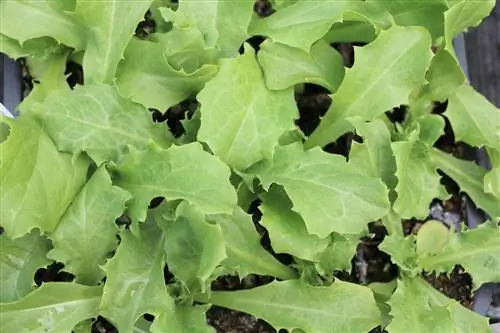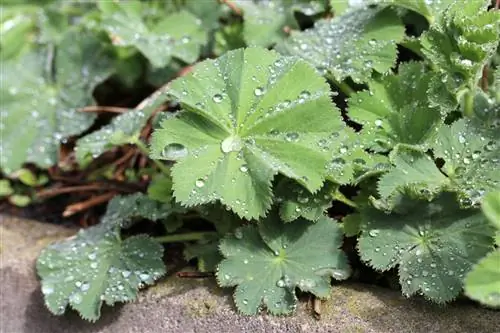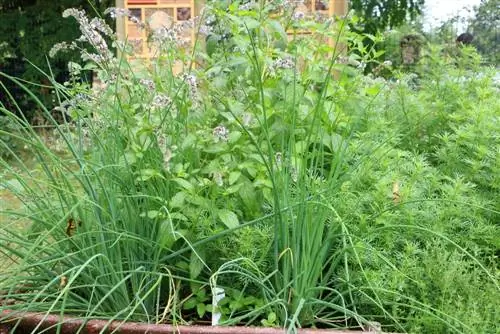- Author admin [email protected].
- Public 2023-12-17 03:39.
- Last modified 2025-01-24 12:45.
Endive is one of the last lettuces that can be planted and harvested during the year. It is easy to care for and does not require a lot of attention. Of course, nothing works with endive on its own, but in contrast to other leaf lettuces it is also frugal.
Preparing the soil
Endives don't place any great demands on the soil, as they are a relatively undemanding plant. It is enough if the soil has been treated with compost, fertilizer or manure to give the endive or other vegetable plants all the nutrients. However, this should be done a few months in advance, which can often be in autumn or winter. Since the seeds are sown very late, other vegetables or salads can be planted beforehand. When these vegetables have made room, sowing can begin.
Sowing time between June and July
Since this lettuce is planted late, it can be sown either in the greenhouse or in a growing bed. But direct sowing in the garden is also possible. However, this should not take place before the end of June and ideally not until the beginning of July. Otherwise it can lead to early flowering, which should be avoided at all costs. The seeds can also be sown directly on site during this time, but here too a minimum distance of 30 to 40 centimeters must be maintained. If you want to harvest endives for a longer period of time, you can sow again after 20 to 30 days. The plant loves the sun and should therefore be given an appropriate place in the garden. Although the endive needs a lot of space, it can be planted or sown next to other vegetables such as cabbage or fennel.
Care and watering
Although the endive does not require much attention, it of course also has demands. Lettuce should only be planted in the same place every three years. This lettuce is a biennial plant, but is replanted every year as it is used. Since the soil is not particularly demanding, it can also be planted after potatoes or tomatoes. Since the other two vegetables require different nutrients, this is easily possible. Of course, after sowing, you have to water well, which means the lettuce grows faster and better. However, the moisture must not accumulate as the endive cannot tolerate it. If the leaves change, then too much water has been given. Simply reduce the water supply here.
bleaching the leaves
After about three months the endive is ready to harvest. The salad can be bleached beforehand. To do this, simply tie the outer leaves together. This means that the inner leaves no longer get any sun and it also reduces the bitter taste. Bleaching can also be done by putting a bucket over it, but the lettuce must be completely dry. Otherwise water can build up and the leaves can rot. Because the endive doesn't like it too wet. Bleaching can be done two weeks before harvest. New varieties are no longer as bitter and therefore this process does not have to be done.
Pests don’t like endive that much
Pests don't really love this lettuce, but snails or aphids can also attack it. The snails can be easily removed by hand or a chemical agent can be used. With aphids it looks a little different, but here you can first use a lye and water mixture. If this treatment is not successful, a chemical agent can be used. For prevention, there are so-called culture nets that help prevent aphid infestation. A disease of endives is downy mildew, which always occurs when sufficient time is not maintained. So it's better to wait a little longer before replanting to avoid this disease. Another disease is leaf edge burn. The cause of this disease is not known, but it is suspected that the soil is deficient in magnesium.
Low cold does not harm the salad
The harvest time usually begins between August and November, which depends entirely on the sowing. If it gets a little colder, it won't really harm the salad. The lettuce should only be harvested from minus 5 degrees or protected against the cold with mats. This means that the lettuce with the roots can be kept longer in the dark cellar. To do this, simply place the endive in damp sand. This only lasts for a few days in the fridge before it is no longer edible. Not only is endive easy to grow in the garden, it also tastes great. Especially if it was grown in your own garden. Especially since endives are not sensitive and undemanding, they can also be grown by hobby gardeners who do not have much experience.
From sowing to harvest
- Can be grown first in the greenhouse
- Direct sowing is also possible
- Sowing between the end of June and mid-July
- It is best to plant in beds where potatoes or tomatoes were previously planted
- Keep 30-40 cm away
- Water well after sowing
- Bleach with a bucket or tie up
- You can harvest after three months
- Withstands temperatures down to -5 degrees
- Can be stored in a dark cellar with roots and moist sand for a long time
Simple handling with great success
If you stick to these few points, you can harvest delicious endive in your own garden without much effort. Not much is necessary for this, apart from perhaps fertilizing the soil over the winter. All of this can be done using natural means, without any chemicals. Simple yet he althy.
Processing and care tips
Recipe & preparation of endive salad: The best way to prepare endive salad is with cold-pressed olive oil and balsamic vinegar; these two ingredients significantly enhance the taste. In addition, you can add lean sheep's cheese, mozzarella, or other lean cheeses to the salad, as well as olives, tomatoes, and other vegetables. The leaves of the curly endive are also very suitable for decoration on the edge of a plate, or as a natural salad bowl insert if you place the leaves in a small salad bowl so that the curled leaf edges can peek over the edge of the bowl.
The endive needs humus-rich soil with medium nutrients. A sunny location is preferred. If you want to sow endives directly outdoors, you should wait until mid-June. Sowing outdoors is possible from mid-June to mid-July. This also prevents shooting. Endive, like almost every other type of lettuce, is often attacked by snails. Slug pellets on the edges of the bed can be a big help here. If you don't want to use chemicals in the garden, you have to collect the snails by hand, which can sometimes be a lengthy job. The endive grows very well in mixed cultures with other vegetables, and also likes to grow alongside other types of lettuce. It is not uncommon to see the plant alternating with lettuce. This smooth and curly variety not only looks pretty, but also allows you to ensure there are enough greens in your diet. Very good neighbors to endive are leek, cabbage, runner beans and also fennel. It is not known that endive would grow worse in the vicinity of other plants.






